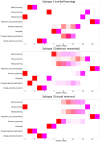Exploring cognitive progression subtypes in the Framingham Heart Study
- PMID: 38515438
- PMCID: PMC10955221
- DOI: 10.1002/dad2.12574
Exploring cognitive progression subtypes in the Framingham Heart Study
Abstract
Introduction: Alzheimer's disease (AD) is a heterogeneous disorder characterized by complex underlying neuropathology that is not fully understood. This study aimed to identify cognitive progression subtypes and examine their correlation with clinical outcomes.
Methods: Participants of this study were recruited from the Framingham Heart Study. The Subtype and Stage Inference (SuStaIn) method was used to identify cognitive progression subtypes based on eight cognitive domains.
Results: Three cognitive progression subtypes were identified, including verbal learning (Subtype 1), abstract reasoning (Subtype 2), and visual memory (Subtype 3). These subtypes represent different domains of cognitive decline during the progression of AD. Significant differences in age of onset among the different subtypes were also observed. A higher SuStaIn stage was significantly associated with increased mortality risk.
Discussion: This study provides a characterization of AD heterogeneity in cognitive progression, emphasizing the importance of developing personalized approaches for risk stratification and intervention.
Highlights: We used the Subtype and Stage Inference (SuStaIn) method to identify three cognitive progression subtypes.Different subtypes have significant variations in age of onset.Higher stages of progression are associated with increased mortality risk.
Keywords: Alzheimer's disease; age of onset; cognitive progression; heterogeneity; machine learning; mortality.
© 2024 The Authors. Alzheimer's & Dementia: Diagnosis, Assessment & Disease Monitoring published by Wiley Periodicals LLC on behalf of Alzheimer's Association.
Conflict of interest statement
R.A. is a scientific advisor to Signant Health and NovoNordisk, and a consultant to the Davos Alzheimer's Collaborative. The other authors declare no conflicts of interest. Author disclosures are available in the supporting information.
Figures



References
-
- Van Der Vlies AE, Verwey NA, Bouwman FH, et al. CSF biomarkers in relationship to cognitive profiles in Alzheimer disease. Neurology. 2009;72(12):1056‐1061. - PubMed
-
- Van Der Flier WM, Pijnenburg YAl, Fox NC, Scheltens P. Early‐onset versus late‐onset Alzheimer's disease: the case of the missing APOE ɛ4 allele. Lancet Neurol. 2011;10(3):280‐288. - PubMed
-
- Sang Z, Wang K, Dong J, Tang L. Alzheimer's disease: updated multi‐targets therapeutics are in clinical and in progress. Eur J Med Chem. 2022:114464. - PubMed
Grants and funding
LinkOut - more resources
Full Text Sources
